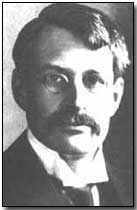Primary Documents - G.M. Trevelyan on the Eleventh Battle of the Isonzo, 1917
 Reproduced below is an
account of the outcome of the
Eleventh Battle of the Isonzo, launched by the Italian
Commander-in-Chief
Luigi Cadorna in August 1917.
Reproduced below is an
account of the outcome of the
Eleventh Battle of the Isonzo, launched by the Italian
Commander-in-Chief
Luigi Cadorna in August 1917.
The summary was written by the head of the British Red Cross effort in Italy, G.M. Trevelyan. Click here to read the view of the U.S. Ambassador to Italy, Thomas Nelson Page.
G.M. Trevelyan, Head of the British Red Cross in Italy, on the Eleventh Battle of the Isonzo
Many began to see little chance of winning the war, as week after week during that summer and autumn more and more Austrian batteries and battalions gave evidence of their arrival from the Russian front.
But in spite of all this, the finest effort of the Italian army was made in the last half of August and the first half of September, 1917. It was only after that magnificent and largely successful effort that the fruits of discouragement were reaped in late October.
The month of the most continuously fierce fighting in the whole Italian war opened on August 18, 1917, with a general bombardment from Tolmino to the sea. The guns massed along the Corada ridge searched the Austrian positions beyond the Isonzo.
Next day, along the front from Plava northwards to Doblar, the infantry bridged and crossed the rapid river in face of the enemy, and began to ascend the eastern bank of the gorge. A more difficult operation, in face of machine-gun posts and a determined foe entrenched in ground of such vantage, has seldom been allotted to any force in the world war.
Here and there a politically weak link in the enemy armour, like the Czechs on Monte Jelenik, rendered a general success just possible. Gradually, as day followed day of carnage, point after point was won. The high-lying hamlet of Vrh fell, and Hill 711, keys to a whole region. Near Plava, operations began with a false attack on Monte Santo to the south, while to the north the foot of the Robot valley was seized.
But far to northward there was a serious setback. The attempt to turn from the south the positions of the enemy in the Santa Lucia and Tolmino region was held to be so important that General Badoglio himself had charge of that operation. But the Austrians could not be dislodged from their fastness round Lom protected by the steep banks of the Vogercek torrent. By this failure the strategic way was left open for the disaster of Caporetto.
The fall of Jelenik was followed on the 23rd and 24th of August by the decisive battle on Vodice and Kobilek, which opened out the Italian advance over the south of the Bainsizza plateau, as the victory on Jelenik had already opened it out over the part to the north.
On the crest and flanks of Vodice both sides had been entrenched at close quarters ever since the battle in May. The hero of Vodice was the fine old soldier, General Prince Gonzaga. He combined a complete control of the operations of his Division with a boyish enjoyment of danger, a perpetual appearance on the top of the disputed mountain and a gaiety which won the hearts of his soldiers and of all who came near him.
On the 24th of August he and his troops had the reward of their long vigil; the whole system of Austrian trenches running from the farther part of Vodice round, the head of the Robot valley on to Kobilek itself, after being subjected to a destructive bombardment, was stormed in the grand style.
Once this obstacle was passed, the pursuit went raging over the Bainsizza plateau with the dash characteristic of the Italians whenever they are well led. Part of the enemy were driven steeply down into the Gargaro valley and chased along it to the northern foot of San Gabriele. Monte Santo was turned, surrounded, and forced to surrender; at long last the "red, white, and green" waved over the ruined convent on the summit, that Italian eyes had gazed on so enviously for two long years.
Farther to the north the conquerors of Kobilek, sweeping across the valley in which Ravne village lies, mounted the limestone crags of the heights beyond, which might have been easily defended, and had, indeed, been prepared for defense, but were carried in that first triumphant rush.
On the afternoon of the 24th of August, standing on a line of trenches near Vodice in which the Austrians had been that morning, Baker and I saw a little string of men, black against the white limestone, struggling up those heights beyond Ravne, three miles away as the crow flies. At first we thought they were retreating Austrians, but presently, when the batteries on Ternovo began to shell them, we realized that they were the Italians who had a few hours before stormed the ground we stood on, and were now ranging over hill and valley like hounds on the trail.
The string of men soon disappeared over the mountain top, where they and their comrades established on the far side the farthest line that Italy ever reached before the great Retreat.
Source: Source Records of the Great War, Vol. V, ed. Charles F. Horne, National Alumni 1923
By 1918 the percentage of women to men working in Britain had risen to 37% from 24% at the start of the war.
- Did you know?
